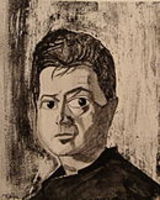Irish portrait artist Reginald Gray who notably produced a portrait from life of fellow-countryman Francis Bacon now in the National Portrait Gallery in London died at 82 in Paris after a cancer illness.

Born in Dublin in 1930, Gray joined at 19 The Dublin Atelier a small group of painters who exhibited at The Dublin Painters Gallery.During this period Gray was inspired by the early works of the French painter Bernard Buffet who had won the Prix de la critique in Paris in 1948 when was twenty. Gray then studied at The National College of Art in 1953.before moving in 1957 to London, where he joined the School of London led by Francis Bacon, Lucian Freud and Frank Auerbach.

Francis Bacon by Reginald Gray
In 1960, he painted a portrait of Bacon which now hangs in the permanent collection of the National Portrait Gallery in London.He subsequently painted portraits from life of writers, musicians and artists such as Samuel Beckett, Harold Pinter, Brendan Behan,Ted Hughes, Rupert Everett and Yves Saint Laurent.
In 1993 Gray had a retrospective exhibition at UNESCO in Paris and in 2006, his portrait "The White Blouse" won the Sandro Botticelli Prize in Florence, Italy.
Gray first married Catherine Hall in 1958 and had a solo exhibition in London in 1960. He then met Francis Bacon and painted his portrait, which was bought by the collector Aubrey Beese, who donated it in 1975 to the National Portrait Gallery, London where it remains today. After his marriage went apart, Gray moved in 1963 to France and stopped in Rouen on his way to Paris. There he had an exhibition of his works but did not sell much of these.
After passing a dire winter in Rouen, Gray survived as a pavement artist copying old masters on the kerbs of that city before exhibiting his works at the Salon des Artistes Normands and at the Musée des Beaux-Arts.
Gray then decided in 1964 to go to Paris and lived at the Académie de Feu on rue Delambre, just behind the famous La Coupole restaurant, run by the Hungarian sculptor Laszlo Szabo who mounted an exhibition titled"Le Monde après les buildings" at which Henry Moore and the Italian artist Marino Marini showed some of their works.
Working from 1965 as a copy boy and illustrator at the New York Times International edition where I first met him, Gray continued to exhibit in small galleries and lived respectively in small rooms in Rue Descartes et rue des Saint-Pères. During the 1968 student revolution in Paris Gray met the young Australian writer Jill Neville and painted her portrait (National Portrait Gallery, Australia) and went on to work at Fairchild Publications and as a fashion photographer for over five years, covering collections in Paris, Milan, Rome and London. He also worked as cameraman filming the fashion collections for German Vogue and Swedish Television. Gray directed his first full length feature Jeu (game, also known as Le Passant)[ starring Laurent Terzieff, Dirk Kinnane, Pascale de Boysson and Bibi Hure.
Gray then lived in the Chateau de Ravenel, 50 miles north of Paris and raised his second daughter Deirdre and son Terence there during a stay that lasted ten years.
From 1993, Gray taught painting at The Irish College in Paris. In 1996, he directed and designed the setting for Letters from Ireland by Belgian playwright Philippe Alkemade, opening at The Wexford Festival and touring Ireland. In this later period he had many one man exhibitions in Paris Galleries such as Galerie Marie de Holmsky, Gallerie de la Grande Chaumière, the Atelier Visconti, and the Salon de Montparnasse, also exhibiting with the late American artist Gregory Masurovsky before having a large retrospective at the Unesco headquarters in 1994.